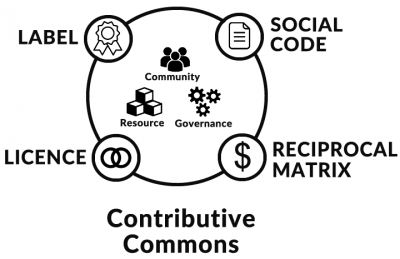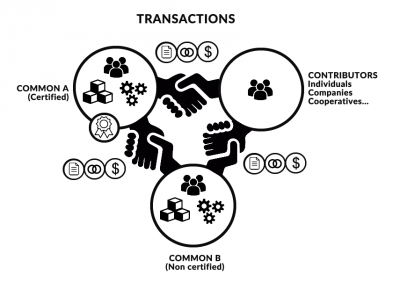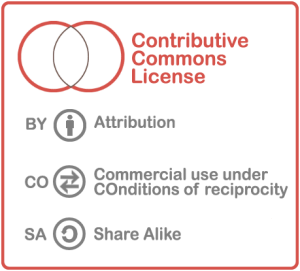Synthesis
After analyzing the reciprocity licensing proposals and previous studies on the subject, the conclusion seems to be that a reciprocity license alone can’t reflect all of the necessary conditions for the regulation of commercial transactions given that they are authorized for commons. In particular, it seems a compromise to draft consensus terms since they are based on moral values.
More than a license, the Contributive Commons propose a set of articulated tools in order to create the conditions for a reciprocal transaction between a common and contributors:

- A Contributive Commons Label which is a peer-to-peer self-agreement.
The label is intended for community members who identify themselves as working for a commons. It has an incentive and pedagogical purpose. It allows a generic definition of the commons (lowest common denominator) Examples: Move Commons – Unisson (in French)
- A Contributive Commons License: inspired by Commercial Creative Commons licenses (CC BY and CC BY SA), it adds conditions to the commercial use of commons.
The license defines the general conditions of access and diffusion, but it withdraws the conditions of commercial use in a different document called a « social code ».
- A Social Code: text that defines the bundles of qualities, values, rights and wealth of the common, and contains a reciprocal matrix.
The terms of commercial use and transactions are set by each common and explained through its social code including a reciprocity matrix (which can be considered the equivalent of a commercial contract). Example: Social Code of French association Semeoz
- A Reciprocity Matrix: equivalent to a rate schedule that clearly indicates contributors’ conditions of payments depending on the use made of the common. This matrix is in the social code.
Examples: FreePlayMusic (23 rates based on the use) – French reciprocity agreement of a third place
- A money: unencrypted and abundant, it is just to clarify the interaction between the labeled commons.
This money, which is not essential to the implementation of the Contributive Commons, would be dedicated to commons exchanges in order to promote the economy of the commons and secure these exchanges compared to the external market. Examples: Local Exchange Trading Systems, WIR, SME (balanced monetary union, in French), KRONOS

Principle of inclusion: any contact being allowed to use the common (including commercial use) is necessarily a contributor whose contribution is received with goodwill by the community regardless of the form of this contribution (including whether it is money).
A contributor (individual, company, cooperative, common …) does not necessarily have the label, but shall accept in full knowledge the terms of the transaction proposed by the common.
Any user of the common is encouraged to also be a contributor (an expression of gratitude or the payment of a sum of money are contributions).
Each common decides the conditions of reciprocity it wishes to include in its social code and reciprocal matrix. This allows endless possibilities, depending on the values and objectives of each community. Example: a common shares a resource with another accredited common, but requires a financial contribution to a non-accredited contributor.
To use the Contributive Commons License, a common necessarily must have the Contributive Commons Label.
The mention of the Contributive Commons will necessarily be accompanied by a URL link to the Social Code that contains the reciprocal matrix. It can for example be mentioned as follows:
![]()
« This content is under Contributive Commons License BY – CO – SA. Please always refer to the [#|terms of commercial use] »
This principle requires to establish a digital notaries guaranteeing the validity of a Social Code on the date of the transaction.
Characteristics
Commons defined by 4 types of bundles
Following John Commons and Elinor Ostrom who defined bundles of rights for commons, the Contributive Commons proposes to extend the principle by defining a common around 4 main bundles:
- Bundles of qualities : the essence of the common, its social function, the contours of the managed resource
- Bundles of values : political, moral, social, ecological, artistic values shared by the common
- Bundles of rights : ownership, access, passage, use, modification, alienation, sharing rules…
- Bundles of wealth : the payment, transactions, financial management, redistribution, partnerships methods…
See « Des exemples de matrices à jardiner collectivement » (in French)
Details
Model a Social Code adapted for the license
See the definition of the Social Code (in French)
 Under the Contributive Commons, the Social Code can a minima contain a description of the following bundles:
Under the Contributive Commons, the Social Code can a minima contain a description of the following bundles:
- the qualities of the common, ie the main features of the managed resource (informational, tangible …), legal status (informal collective, association, cooperative, business, etc …), the nature of pooling resources (goods, practices, …) and a reminder of its history;
- the values shared by the community, including the type of governance which it adopts, the common responsibility or common interests that the community wishes to maintain, its relationship with nature, art, education, technology, sharing, etc…;
- the rights of access, passage, use, modification, etc … the distribution of these rights among different categories of contributors (users, partners, private and public actors, …) and the conditions for modification of these rights;
- the wealth recognized by the community (monetary or not), its funding sources, and how it intends to manage their flows according to different categories of contributors, in the form of reciprocity agreements or reciprocity matrix (possibly including sharing, donation and gratuity) and a description of the redistribution of internal flow.
Work to do: to model a Social Code adapted for the license, with the objective of:
- structure the Social Code including the 4 main themes defining a common (resource / community / governance / rules), that describe the types of bundles (qualities, values, rights, wealth) and containing reciprocity matrix;
- propose a summary sheet on top of the social code that allows to understand at a glance what are the particular financial contribution arrangements (creating a visual code in connection with the label);
- to ensure that the essential points of a typical commercial contract are met.
There would probably several levels to create:
- a summary easy to read for a first approach including the points of the label: see an example (in French)
- an easy to read intermediate version (2 or 3 pages)
- a comprehensive reference text whose « standardized » plot remains to be established (this frame contains the elements of the label items to facilitate the evaluation of the common but also the minimum legally required for a commercial contract)
- further version in which the frame is divided into computerizable detailed points (semantization) : see an example (in French)
The Contributive Commons Label
 The principle is to create a label gathering criteria to:
The principle is to create a label gathering criteria to:
- help contributors and partners (public or private) to understand the values and functioning of the common
- find more commons with similar interests
- attracting contributors to the common
- create a common label network to facilitate transactions
This label must be able to assess quickly:
- The type of governance chosen by the community
- The terms of contribution
- Resource sharing arrangements
- The legal framework chosen by the common to ensure its preservation
- Logic of financing and financial redistribution in the common
- The arrangements for creating partnerships
See the 6 ingredients of Unisson (in French)
To use the Contributive Commons License, a common will necessarily have the label.
To access this label, a common will necessarily have drafted its Social Code (describing bundles and a reciprocal matrix) to enable a community of peers to assess the common.
The Contributive Commons Community
 The Contributive Commons Community is today an informal collective that reflects and tests the principles proposed on the site.
The Contributive Commons Community is today an informal collective that reflects and tests the principles proposed on the site.
Eventually, it will be structured around governance so as to deliver the Contributive Commons Label via a peer committee. This structure could be supported locally by the Chambers of the Commons.
A first concrete experimentation will be born in Lille (France) in the form of the association Contributive Service for Commons L1 (being established).
Examples
An example of Contributive Commons License
Contributive Commons License BY CO SA
By using the Contributive Commons License BY CO SA 1 for the commons, you are free to:
- Share — copy and redistribute the material in any medium or format
- Adapt — remix, transform, and build upon the material
 Under the following terms:
Under the following terms:
- Attribution — You must give appropriate credit, provide a link to the license, and indicate if changes were made. You may do so in any reasonable manner, but not in any way that suggests the licensor endorses you or your use.
- ShareAlike — If you remix, transform, or build upon the material, you must distribute your contributions under the same license as the original.
- Commercial use under conditions — You are permitted to make commercial use of this work, all or part of the hardware if you meet the criteria of a « contributor » in the Social Code of the common covered by this license, and if you settle the possible fee contributory mentioned in the reciprocal matrix indicated in this Social Code.
No additional restrictions — You may not apply legal terms or technological measures that legally restrict others from doing anything the license permits.
Notices : This is a human-readable summary of (and not a substitute for) the complete license. It is not a license, It is not a license and has no legal value. You should carefully review all of the terms and conditions of the actual license before using the licensed material. Contributive Commons is not a law firm and does not provide legal services. Distributing, displaying, or linking to this deed or the license that it summarizes does not create a lawyer-client or any other relationship.